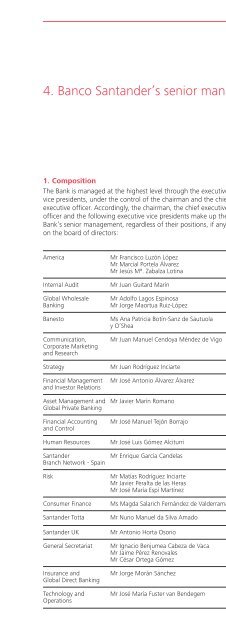You also want an ePaper? Increase the reach of your titles
YUMPU automatically turns print PDFs into web optimized ePapers that Google loves.
150The risk parameters also calculate the regulatory capital inaccordance with the rules of the new Basel Capital Accord(BIS II). The regulatory capital is the difference between theunexpected and the expected loss.The unexpected loss is the basis for calculating the capitaland makes reference to a very high level of loss, but not veryprobable, not considered recurrent and which must metwith equity.Estimates of the risk parameters (PD, LGD and EaD) should bebased on internal experience – i.e. on observations of defaultsand experience in recovering these operations.In portfolios where the internal experience of defaults is scant,such as banks, sovereigns or global wholesale banking,estimates of the parameters come from alternative sources:market prices or studies by external agencies which draw on theshared experience of a sufficient number of institutions. Theseportfolios are called low default portfolios.For the rest of portfolios, estimates are based on the institution’sinternal experience. The PD is calculated by observing the NPLentries and putting them in relation to the final rating assignedto the customer or with the scoring assigned to the operations.The LGD calculation is based on observing the recovery processof operations not fulfilled, taking into account not only therevenues and costs associated with this process, but also themoment when they are produced and the indirect costs incurredin recovery activity.The estimation of the EaD comes from comparing the use ofthe lines committed at the moment of default and a normalsituation, in order to identify the real consumption of the linesat the time of default.The parameters estimated for global portfolios are the same forall the Group’s units. A financial institution with a rating of 8.5will have the same PD regardless of the unit in which itsexposure is recorded. On the other hand, retail portfolios havespecific scoring systems in each unit of the group. This requiresseparate estimates and specific assignment in each case.C. Master scale of global ratingsThe models committee approved the following relation betweeninternal rating and probability of default (PD) for the globalportfolios of banks and global wholesale banking.Probability of defaultInternal rating PD Wholesale Banking PD Banks9.3 0.018% 0.013%9.2 0.020% 0.014%9.0 0.024% 0.018%8.5 0.037% 0.029%8.0 0.060% 0.049%7.5 0.095% 0.083%7.0 0.151% 0.139%6.5 0.240% 0.232%6.0 0.382% 0.390%5.5 0.607% 0.653%5.0 0.965% 1.095%4.5 1.535% 1.835%4.0 2.442% 3.076%3.5 3.884% 5.157%3.0 6.178% 8.645%2.5 9.826% 14.492%2.0 15.627% 24.294%1.5 24.855% 40.725%1.0 39.532% 68.268%These PDs are applied uniformly throughout the group inaccordance with the global management of these portfolios. Ascan be seen, the PD assigned to the internal rating is not exactlyequal for a same rating in both portfolios, although it is verysimilar in the tranches where most of the exposure isconcentrated (i.e. in tranches of rating of more than six).The parameters are then assigned to the operations present inthe balance sheet of units in order to calculate the expectedlosses and the capital requirements associated with theirexposure.<strong>Annual</strong> Report <strong>2009</strong> Risk management
















